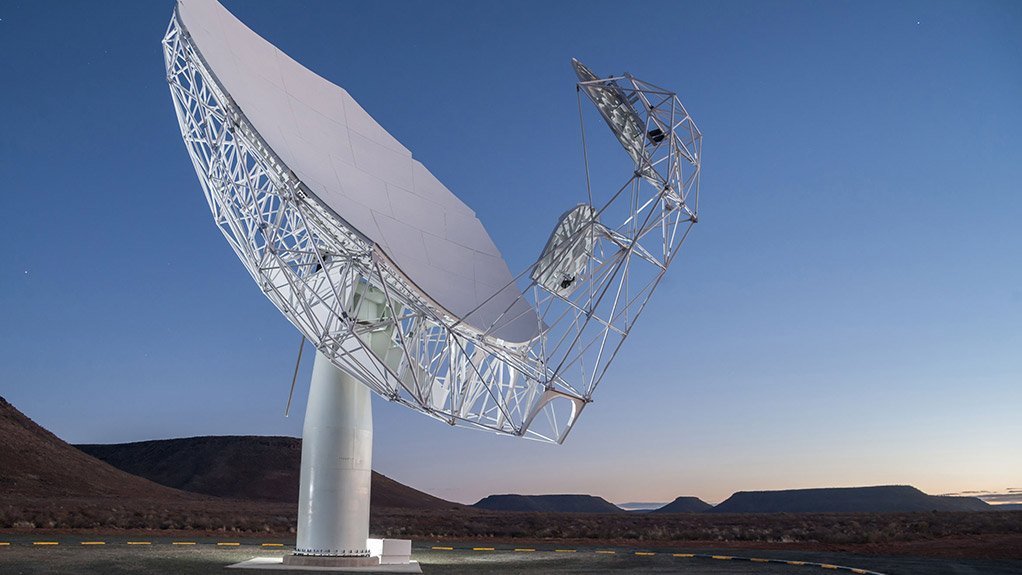
+27 (0)11 0461900
Private Bag X139 Halfway House 1685

MeerKAT telescope project, South Africa
Name and Location
MeerKAT telescope project, Northern Cape, South Africa.
Client
The Square Kilometre Array South Africa (SKA SA) is the agency that drove South Africa’s bid to host the €1.5-billion international SKA radio telescope and the MeerKAT programme.
Project Description
South Africa’s MeerKAT radio telescope array is intended to be a precursor of the international SKA radio telescope. The MeerKAT evolved from the original idea of a Karoo Array Telescope (KAT).
The reference design specification for the full MeerKAT is 64 offset dishes, each with a diameter of 13.5 m, with single-pixel wideband feeds covering the 500 MHz to 2.5 GHz frequency range. The design means that there are no struts over the dish, which can reduce or scatter incoming radio waves, thus increasing the sensitivity of the antenna.
The completed MeerKAT will have a central core, but some dishes are almost 10 km apart, thus replicating the SKA on a small scale.
It will also facilitate the installation of multiple receiver systems in the primary and secondary focal areas and is the reference design for the midband SKA concept.
The MeerKAT will be delivered in three phases.
The first phase – the MeerKAT Precursor Array, known as KAT-7 and which comprises seven 12-m-diameter composite parabolic dishes at the Karoo site – was completed in 2010.
This prototype interferometer array serves as an engineering test-bed for technologies and systems and as an operational radio telescope. MeerKAT is designed to be integrated into the international Square Kilometre Array (SKA) radio telescope, which will be cohosted by South Africa and Australia.
Value
The estimated cost is R900-million.
Duration
The commissioning of MeerKAT is scheduled for 2014/15, with the array coming on line for science operations in 2016. This phase includes all antennas, but only the first receiver will be fitted and a processing bandwidth of 750 MHz will be available.
For MeerKAT Phase 2 and Phase 3, the remaining two receivers will be fitted and the processing bandwidth will be increased to at least 2 GHz, and later to 4 GHz.
Latest developments
Germany’s Max-Planck-Society (MPG) and the Max Planck Institute for Radio Astronomy (MPlfR) are investing €11-million (about R150-million) in South Africa’s MeerKAT radio telescope array programme. The money will be used to design, build and install S-band radio-wave receivers on MeerKAT’s dishes. The S-band covers radio frequencies between 2 GHz and 4 Ghz.
The German receivers will be used mainly to study pulsars – rapidly spinning neutron stars, which emit incredibly regular radio pulses. They can thus be used as very accurate clocks to test extreme physics. The South African receivers will operate in the L-band (1 GHz to 2 Ghz) and in the UHF-band (ultrahigh frequency: 580 MHz to 1.05 GHz) range.
Key Contracts and Suppliers
Group Five Coastal (building foundations); Schneider Electric South Africa (building management system); Stratosat Datacom (part of Germany’s Schauenburg Group), with its technology partners, General Dynamics Satcom, of the US, and Vertex Antennentechnik, of Germany (design, construction, installation and commissioning of antennas); Efficient Engineering (antenna pedestals and yokes); Tricom Structures (backup structures for dishes); Titanus Slew Rings (main azimuth bearings); National Research Council of Canada (low-noise amplifiers); Oxford Cryosystems (cryogenic cooling system) and Brink & Heath Civils (foundations), Max-Planck-Society and Max Planck Institute for Radio Astronomy (S-band radio- wave receivers).
On Budget and on Time?
The project is on schedule.
Contact Details for Project Information
MeerKAT engineering office, tel +27 21 506 7300 or fax +27 21 506 7375.
Group Five Coastal, tel +27 31 5690300 or fax +27 31 569 0420.
Schneider Electric South Africa, tel +27 11 254 6400,
fax +27 11 254 6700/6704 or email enquiries@za.schneider-electric.com.
Stratosat Datacom, tel +27 11 974 0006 or fax +27 11 974 0068.
General Dynamics Satcom technologies, tel +1 828 464 4141, fax +1 828 464 4147 or email info@gdsatcom.com.
Brink & Heath Civils, tel +27 21 551 2640, fax +27 21 551 2977 or email admin@brinkheath.co.za.
Efficient Engineering, tel +27 11 928 4800, fax +27 11 974 8719 or email info@efficient.co.za.
Tricom Structures, tel +27 12 803 0041, fax +27 12 803 6040 or email info@tricom1.co.za.
Titanus Slew Rings, Shabana Cotwal, +27 11 974 7017, fax + 27 11 974 8109 or email shabana@tsr.co.za.
National Research Council of Canada, tel +1 613 993 9101, fax +1 613 952 9907 or email info@nrc-cnrc.gc.ca.
Oxford Cryosystems, tel +44 1993 883 488.
Max-Planck-Society, tel +49 89 2108-1275 or email beck@gv.mpg.de.
Max Planck Institute for Radio Astronomy, tel +49 228 5250 or fax +49 228 525 229.




